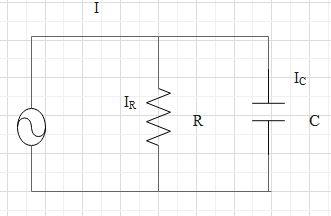Answer
414.6k+ views
Hint-For a parallel RC circuit the resistance and capacitor will be connected parallel to each other. Let the current through the resistive branch be ${I_R}$ and current through the capacitive branch be ${I_C}$ .Total current $I$ splits into ${I_R}$ and ${I_C}$. The relation between RMS current and peak current is given as
${I_{rms}} = \dfrac{{{I_0}}}{{\sqrt 2 }}$
Where ${I_{rms}}$ is RMS current and ${I_0}$ is the peak current
Using this we can find the value of total rms current in the given circuit.
Step by step solution:
A parallel RC circuit is a circuit in which the resistance and capacitor are connected parallel to each other. Since they are connected in parallel voltage across both resistor and capacitor will be equal.
But the current flowing through the resistive branch and capacitive branch will be different.

Given the current through the resistive branch is
${I_R} = 100\,mA$
Current through the capacitive branch is
${I_C} = 100\,mA$
From the figure we can see that total current $I$ splits into ${I_R}$ and ${I_C}$ .
hence total current in the circuit can be found out by adding current in the resistive branch and current in the capacitive branch.
Thus, we can write,
$I = {I_R} + {I_C}$
Let us substitute the value of current in the resistive branch and capacitive branch in the above equation to find the total current.
$I = 100\,mA + 100\,mA$
$\therefore I = 200\,mA$
We are asked to find the RMS current.
The relation between RMS current and peak current is given as
${I_{rms}} = \dfrac{{{I_0}}}{{\sqrt 2 }}$
Where ${I_{rms}}$ is RMS current and ${I_0}$ is the peak current
On substituting the value of peak current, we get
${I_{rms}} = \dfrac{{200\,mA}}{{\sqrt 2 }}$
$\therefore {I_{rms}} = 141\,mA$
So, the answer is option D
Note:In the question RMS value of current is asked. When we add the given values of current through resistor and current through capacitor what we get is the peak current always remember to convert it into RMS current by dividing it by $\sqrt 2 $ .
${I_{rms}} = \dfrac{{{I_0}}}{{\sqrt 2 }}$
Where ${I_{rms}}$ is RMS current and ${I_0}$ is the peak current
Using this we can find the value of total rms current in the given circuit.
Step by step solution:
A parallel RC circuit is a circuit in which the resistance and capacitor are connected parallel to each other. Since they are connected in parallel voltage across both resistor and capacitor will be equal.
But the current flowing through the resistive branch and capacitive branch will be different.

Given the current through the resistive branch is
${I_R} = 100\,mA$
Current through the capacitive branch is
${I_C} = 100\,mA$
From the figure we can see that total current $I$ splits into ${I_R}$ and ${I_C}$ .
hence total current in the circuit can be found out by adding current in the resistive branch and current in the capacitive branch.
Thus, we can write,
$I = {I_R} + {I_C}$
Let us substitute the value of current in the resistive branch and capacitive branch in the above equation to find the total current.
$I = 100\,mA + 100\,mA$
$\therefore I = 200\,mA$
We are asked to find the RMS current.
The relation between RMS current and peak current is given as
${I_{rms}} = \dfrac{{{I_0}}}{{\sqrt 2 }}$
Where ${I_{rms}}$ is RMS current and ${I_0}$ is the peak current
On substituting the value of peak current, we get
${I_{rms}} = \dfrac{{200\,mA}}{{\sqrt 2 }}$
$\therefore {I_{rms}} = 141\,mA$
So, the answer is option D
Note:In the question RMS value of current is asked. When we add the given values of current through resistor and current through capacitor what we get is the peak current always remember to convert it into RMS current by dividing it by $\sqrt 2 $ .
Recently Updated Pages
How many sigma and pi bonds are present in HCequiv class 11 chemistry CBSE

Why Are Noble Gases NonReactive class 11 chemistry CBSE

Let X and Y be the sets of all positive divisors of class 11 maths CBSE

Let x and y be 2 real numbers which satisfy the equations class 11 maths CBSE

Let x 4log 2sqrt 9k 1 + 7 and y dfrac132log 2sqrt5 class 11 maths CBSE

Let x22ax+b20 and x22bx+a20 be two equations Then the class 11 maths CBSE

Trending doubts
Fill the blanks with the suitable prepositions 1 The class 9 english CBSE

At which age domestication of animals started A Neolithic class 11 social science CBSE

Which are the Top 10 Largest Countries of the World?

Give 10 examples for herbs , shrubs , climbers , creepers

Difference between Prokaryotic cell and Eukaryotic class 11 biology CBSE

Difference Between Plant Cell and Animal Cell

Write a letter to the principal requesting him to grant class 10 english CBSE

Change the following sentences into negative and interrogative class 10 english CBSE

Fill in the blanks A 1 lakh ten thousand B 1 million class 9 maths CBSE



